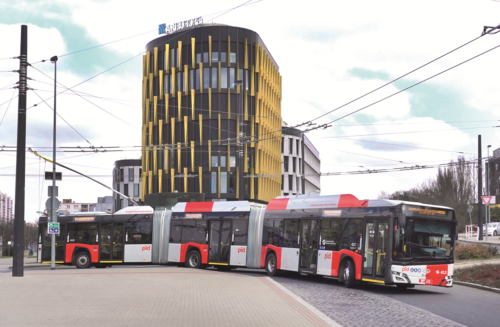
New Solaris battery-electric hybrid trolleybuses are providing a vital link and reducing emissions, reports Andrew Thompson
Since early March, a fleet of 20 double-articulated trolleybuses supplied by a consortium of Solaris and Škoda have been running in revenue service on the newly introduced line 59 from Prague’s Vaclav Havel Airport to the city’s Nádraží Veleslavín metro and tramway interchange. This now electrified route replaces previous diesel bus route 119.
Between Nádraží Veleslavín and the airport’s terminal 3, the 24m long trolleybuses run under the newly installed catenary, while the remaining route section on the airport premises is completed in battery mode. This means that around 58% of the route is equipped with overhead power lines.
Following the city’s previous introduction of trolleybus line 58 between Palmovka and Miškovice, route 59 is now the second trolley service in the Czech capital’s relaunched trolleybus network, which was reintroduced in 2018. The first generation Prague ‘trolejbus’ network opened in 1936 and closed in 1972. By 2026, another five trolleybus lines will be added, which will also have designated numbers in the 50s range, in order to differentiate them from the number schemes of ordinary bus routes.
On weekdays, trolleybuses run up to every three minutes on the high-demand line 59. This is also due to the fact that Prague Airport is one of the few major cities in Europe without a rail link. Thanks to the larger capacity of the double-articulated trolleys, up to 180 people can now travel in one of these three-section vehicles.
The Prague city administration has calculated that by converting the airport link to trolleybus operation, around 690,000 litres of diesel fuel and 1,300 tons of CO2 emissions may be saved annually.

